
Let's take a look at #RayaAndTheLastDragon, the influences and inspirations that went into its setting, my thoughts on the Southeast Asian theme, and my view of the criticisms against it. I'm writing this from memory so I might've forgotten or overlooked stuff 

First off, this is not a review. I enjoyed the movie and I liked the ending song, but I also felt the plot was linear and most of the supporting characters were extended gags with little to no development
I won't be talking about the quality of the movie, just the setting. I haven't read about its production, and I tried to avoid seeing too many opinions other than what appeared on my Facebook feed. So everything here is just me, for better or worse
The movie is set in Kumandra, a land based on Southeast Asia. Shaped like a dragon, it's separated into five regions inhabited by five clans, each named after the part of the dragon they live in 

I've read of a similar concept in geomancy. If you imagine a dragon's body snaking down Asia, the fate of the land is influenced by which part of the dragon where it's located 

Siberia, being the tail, is the unluckiest
Korea and Vietnam are the hindlegs and forelegs respectively, which explains why both countries have so often been split
China is the main portion of the body, making it relatively stable
Korea and Vietnam are the hindlegs and forelegs respectively, which explains why both countries have so often been split
China is the main portion of the body, making it relatively stable
The Malay peninsula is the head, making it very fortunate and mostly safe from natural disasters
Tiny Singapore is the dragon's pearl, which makes it the luckiest of all
Accurate? I'll leave that up to you
Tiny Singapore is the dragon's pearl, which makes it the luckiest of all
Accurate? I'll leave that up to you
It also brings to mind the Mekong, which runs from Tibet to Vietnam, forming a delta known as the Nine Dragons. According to one Thai legend, the Mekong was formed by a dragon or Naga snaking through the ground. Called Phaya Naga, this dragon is said to still dwell in the river 



The clans of Kumandra are not based on specific places, but each draws from certain elements of Southeast Asian cultures and environments to make them unique. First is the desert of Tail, a land of "sneaky mercenaries" 

Deserts are not characteristic of Southeast Asia, but the movie implies that the land only became this way because the loss of the dragons caused the region to dry up. That would also explain why they have water buffaloes, an animal suited to wet terrain 

The people of Tail appear to wear the least clothes among all the five regions. I would've expected a desert culture to keep themselves covered. But considering that their land wasn't originally desertified, maybe their culture developed in what were once humid wetlands 

Their main weapon is the sickle, originally an agricultural tool. Sickles are a major weapon in most styles of silat, and they're particularly important to the silat of Madura. And just like in the movie, sickles can be paired
Then there's Talon, a colourful floating market known for its thievery. Floating markets are very characteristic of Southeast Asia. They're found in many parts of the region, but Thailand tends to get the most publicity 





Now Spine is the most baseless of the five clans. It's a snowy forest country populated by large hardy people who wield battle-axes 

Regular snow occurs in the mountainous parts of northernmost Southeast Asia, namely Vietnam and Myanmar, but is otherwise uncharacteristic of the region. I'm not saying the setting should be limited to what's most common, but.. 

My problem with Spine (no it's not back pain) is that it doesn't resemble any such culture in Southeast Asia. The architecture doesn't look like either Vietnam or Myanmar. I don't imagine any culture of SEA looking like Spine even if they had regular snow 

They also appear to ride elephants. Real elephants prefer warm weather, but this is fantasy so maybe this is a species suited to the cold. I just hope this wasn't supposed to fit the image of burly warriors riding large tough animals 

And then there's the axes. I have a feeling this was inspired more by the stereotype of Vikings than anything in Asia. Axes are not particularly prominent in any Southeast Asian fighting system. But this guy does remind me of Wiro Sableng...

https://twitter.com/uglyluhan/status/1113380223746170880?s=19
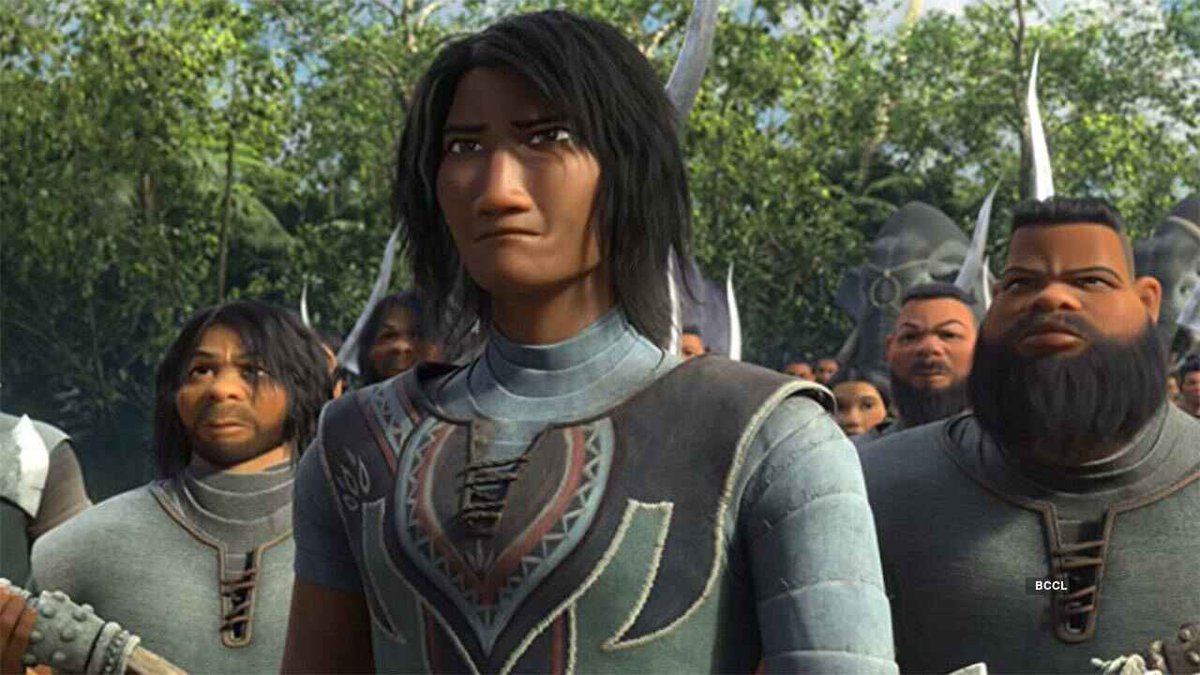
Moving on, there's Fang, the most interesting clan to me because it takes inspiration mainly from the Minangkabau culture of West Sumatra. This might not be immediately apparent 

First, they appear to be matriarchal, bringing to mind the matrilineal system of adat perpatih. Both the chief and generals of Fang are women, and their architecture is clearly inspired by the distinctive Minang roofs 

Raya also mentions that Fang are assassins, which is something the Minang fighters were very good at
https://twitter.com/uglyluhan/status/1113374441692483584?s=19
The Fang warriors ride some species of large cat. Their ears suggest the lynx or caracal, animals unknown in Southeast Asia. To keep with the theme, I would've preferred if they mounted tigers or leopards as some Malay datuk keramat are depicted in statues 

Speaking of mounts, Raya rides her rolling companion Tuk Tuk. According to Scott Watanabe, the original idea for this was a pill bug that mimicked the auto rickshaw of Southeast Asia, known colloquially by the onomatopoeic word tuk-tuk in Thai
instagram.com/p/CMcb_6VDYz3/…
instagram.com/p/CMcb_6VDYz3/…
This really should've been a Southeast Asian pangolin. Unfortunately the final design more closely resembles an armadillo, which is strange since this concept image looks like a pangolin 

And finally, there's the nation of Heart. Along with Talon, Heart seems to be the most typical of Southeast Asia, but especially Thailand, Laos, and Cambodia 

The outer design of the palace was a bad choice for the setting. It seems to be taking cues from Mughal-inspired architecture popular in Muslim-majority parts of Southeast Asia today 

It even has *gasp* the dreaded onion. For those who get defensive about the dome for religious reasons, I did an entire thread explaining that the overrated onions were a colonial introduction
https://twitter.com/uglyluhan/status/1376023767327985669?s=19
None of the five clans are based on any single real-world country or culture, and that's not a bad thing at all. Heart might seem very Thai-Khmer, but Raya's unarmed fighting style is in fact Indo-Malay silat. This stance is unmistakable 

Namaari from the Minang-esque land of Fang uses the Thai martial art of krabi-krabong when armed. Her posture here is the main double sword stance 

Young Raya at the beginning of the movie is armed with a pair of sticks. This combination isn't unique to any specific style or place — heck, two sticks are used in both silat and krabi-krabong — but the way she wields them is decidedly Filipino 

Philippine martial arts are known by many names in the country's various languages, but the most common are arnis, eskrima, and kali. The former two words are of Spanish origin while the latter is indigenous, related to cognates in Indonesian languages 

The Spanish word for stick is baston, still used by Filipino martial artists today, but many Filipinos have taken to using the word arnis for the sticks themselves rather than the art. The use of two sticks is more prominent in the Philippines than any other SEAsian martial art 

When Namaari is unarmed, she uses the Southeast Asian style of kickboxing most commonly known as muay Thai. Though Thailand *arguably* produces the best kickboxers in the region, the art itself isn't unique to Thailand at all 

Known by different names in each country, the same form of kickboxing is also traditionally practiced in Cambodia, Laos and northern Malaysia. The closely related lethwei of Myanmar has a different ruleset 







Muay Thai and silat are the two most representative martial arts of Southeast Asia as a whole, so this was a good decision. The fight scenes are short and few, but they're pretty good AND they're the best representation of SEAsian martial arts in an American animation, hands down 

I also noticed this pair of short-handled tridents at the beginning. These were historically used across Asia, and remain an important weapon in silat. They commonly feature in the logos of silat schools 

The short-handled trident is often misrepresented as a Japanese weapon in American pop culture, but it's far more common in SEA. It's known by many names but I prefer the Indonesian term cabang (pronounced chabang, not the Dutch spelling "tjabang")
https://twitter.com/uglyluhan/status/1113376154147119104?s=19
Raya's sword is based on the keris or kris, a dagger which often (though not always) has a wavy blade. The shape of the blade is the only thing kris-like about the weapon though, as its handle is more like a conventional sword 

There's been some criticism against the weapon's design. Its handle is straight, unlike the pistol-gripped kris. It's also longer than the average kris. To me, that shouldn't be an issue 



First of all, nobody in the film ever called it a kris. As far as I'm concerned, it's a sword with a wavy blade. Concept art shows it as originally being a single-edge sword with a kris-like base
instagram.com/p/CMnQVbXjbvn/…
instagram.com/p/CMnQVbXjbvn/…
The final design adds a dragon-shaped cross guard. Dragon motifs on weapons and other objects fit right in with the Southeast Asian setting
https://twitter.com/uglyluhan/status/1192044323799330816?s=19
I believe that those who complained about the weapon being too long for a kris have limited exposure to real kris. Yes it's a dagger and is usually short, but they commonly reach the size of a long knife 

Some are very large, and stand taller than the average person. Of all the gripes about Raya's sword, the length shouldn't be one of them
https://twitter.com/uglyluhan/status/1107917518797041664?s=19
Besides, this is fantasy. Oversized weapons are nothing new. If you don't let people get creative with something as simple as the size of a weapon, local fantasy will always be dull and stagnant 



What could've used improvement is the sword's general design. If they wanted a wavy-bladed sword, they could've gone with a sundang which also would've let them further showcase Raya's silat/arnis-based fighting style
https://twitter.com/uglyluhan/status/1113370707172352000?s=19
But Raya's style with that sword doesn't seem to have any specific basis or influence. That it can extend into a whip-like form is a pop culture trope that I think would better fit a South Asian setting than Southeast Asia 

When Raya spars with her father Benja, he wields the sword sheathed. While this isn't unique to any particular martial art, it is worth noting that Burmese swords were fixed in the sheathe and wielded that way until it was necessary to break the sheathe against a rock 

Namaari's weapons are typically Thai. She first wields a glaive (ngau), and then two swords (daab song mue) in the final fight 

Now let's look at some aspects of culture in Kumandra. Many are obvious enough, like the food, shadow puppetry and batik
https://twitter.com/aimanariffAAK/status/1369224469282058241?s=19
Occasionally it includes certain foreign foods that have become common in Southeast Asia like chilli, dragonfruit, and watermelon. I would've preferred if they'd stuck to Asian foods, but maybe that's just me 



Besides, the film generally does a good job with the food, and that's something that fictional settings often get wrong. Most of the food in this movie will be instantly recognisable to any Southeast Asian 







One of the first things you're bound to notice about this movie is the prominence of female characters. Aside from the matriarchal land of Fang, Raya is never overshadowed by the men either
slashfilm.com/raya-and-the-l…
slashfilm.com/raya-and-the-l…
These aren't token "strong girls" thrown in as a popular modern trope. Many historical women of Southeast Asia were rulers, traders, shamans, and fighters with an important role in society, as I explained here
https://twitter.com/uglyluhan/status/1278624907681599492?s=19
The film creates an original form of greeting and salutation analogous to the Asian pressed palms. It varies slightly depending on the age and status of the person being addressed 

The pressed palm greeting originated with the Anjali mudra, and spread through SEA along with Hinduism and Buddhism. It's still in common use by Hindu-Buddhist communities throughout the region, but has been dropped from common usage where Islam and Christianity were adopted 







Muslim Southeast Asian communities for a while preserved the custom as a form of thanks or apology, but today it survives only in martial arts, dance, and certain ceremonies
https://twitter.com/uglyluhan/status/1177505524834635777?s=19
A form of this gesture is still used even by Muslims for greeting royalty
my.asiatatler.com/society/royal-…
my.asiatatler.com/society/royal-…

One scene that stood out for me is when Namaari tells Raya that she hasn't had rice in a while. Without the dragons, Fang's outward prosperity conceals "holes" on the inside 

I like this scene because of its parallels with real Southeast Asian history. For all its glory, Melaka was surrounded by swamps and thick jungle, meaning that the kingdom relied on imported food supplies like rice from Java 

The small island of Riau similarly imported rice from Siam. But fertile soil allowed Java to produce vast quantities of rice that could support a large population, and a work force capable of constructing monuments like Borobudur 

Rice production was the secret to the success of Angkor as well. Fang's monumental palace was either built before the loss of the dragons, or the surrounding paddy fields produce enough to sustain the labourers 

Most of the names in the film sound very Southeast Asian, like Boun, Virana, and Pranee. The word raya in Malay means great or high. It's also an alternate form of the word raja (king) in some languages like northern Malay and Thai
Atitaya brings to mind the real name Aditya, of Indian origin but historically used across Southeast Asia
https://twitter.com/RAYAMAARItweets/status/1388330915261161475?s=19
Now let's look at the clothing. Most of the attire of Kumandra is generic Southeast Asian without being specific to particular places. Almost every country in SEA had the topknots, headbands, sampot, and one-shoulder tops
https://twitter.com/uglyluhan/status/1356903866252464128?s=19
Historically Southeast Asians would have commonly worn sandals or gone barefoot. Indian-style curled or pointed shoes were probably worn mainly by the wealthy. You can still see these shoes worn by dancers, and among the Thai regalia 

Now Raya's boots don't quite fit in Southeast Asia. Boots like these are worn in Central Asia, Mongolia and the Himalayan region. If the intention was to make her seem like a rugged hardy character, I think sandals would've been fine 
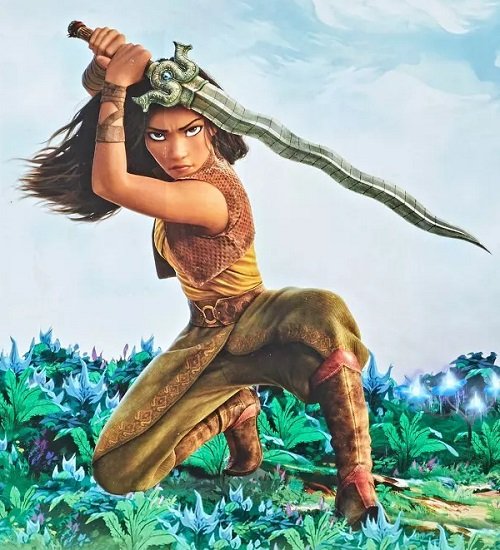
The kemban and sebai appear to be common attire for women in Kumandra. Adult Raya also wears a sebai crossed over her chest in the Thai-Khmer style 
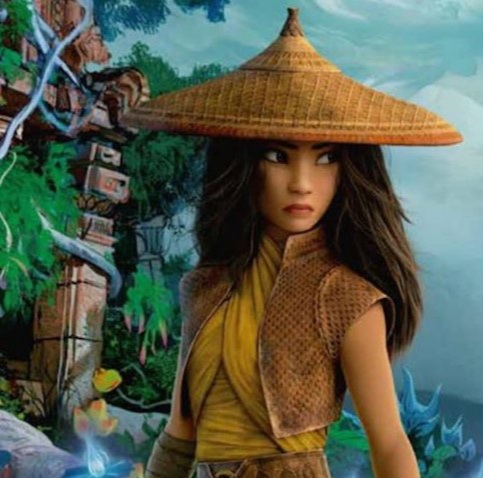
Young Namaari's outfit has a sort of collar, versions of which are found in traditional clothing across Southeast Asia. I assume this specific outfit was inspired by Thai clothing 



Those large bangles and armlets are worn in many cultures of South and Southeast Asia. They're usually gold in Thailand and Cambodia, but they're silver among the Iban 



The outfits worn by Virana & adult Namaari are very modern-looking. Virana's costume in particular looks like it belongs in sci-fi. Their hairstyle doesn't doesn't resemble anything historical in Asia. I don't mind but they do look out of place compared to the rest of Fang 

The only thing I can think of that compares to Namaari's top is the yem, a Vietnamese bodice of Chinese origin. A modified version of this can be used as outerwear 


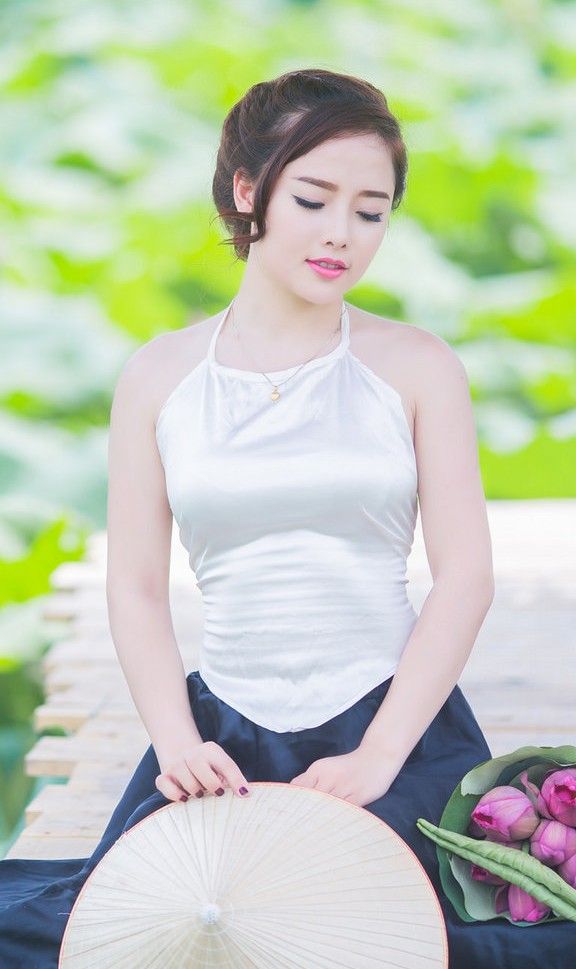
I would've preferred if their clothing had a stronger Minang feel. This art by Lentera Nusantara wouldn't fit into Raya as it is, but it's a good example of how traditional Minang clothes could fit nicely into fantasy
artstation.com/artwork/QR9GE
artstation.com/artwork/QR9GE
I understand if the designers didn't want to base anything on very specific cultures, which is a common decision in fantasy to avoid having direct real-world analogies, but I'd be satisfied with just small hints of Minang influence. For example...
Imagine how imposing Namaari or Virana would look wearing something like this. Even just the headdress
Art by @gambargin
deviantart.com/gambargin/art/…
Art by @gambargin
deviantart.com/gambargin/art/…
Looking at the concept art, I prefer the earlier design of Namaari's clothes, which looks far more traditionally Southeast Asian
instagram.com/p/CMnQVbXjbvn/…
instagram.com/p/CMnQVbXjbvn/…
The earrings worn by Namaari and her mother look like a simplified version of Southeast Asian earcuffs. But... Why would you simplify it? Have you seen how unique our ear ornaments are? Some even look like elf ears 





The conical hat was traditionally worn across South, Southeast and East Asia. Woven straw hats feature frequently in the film 


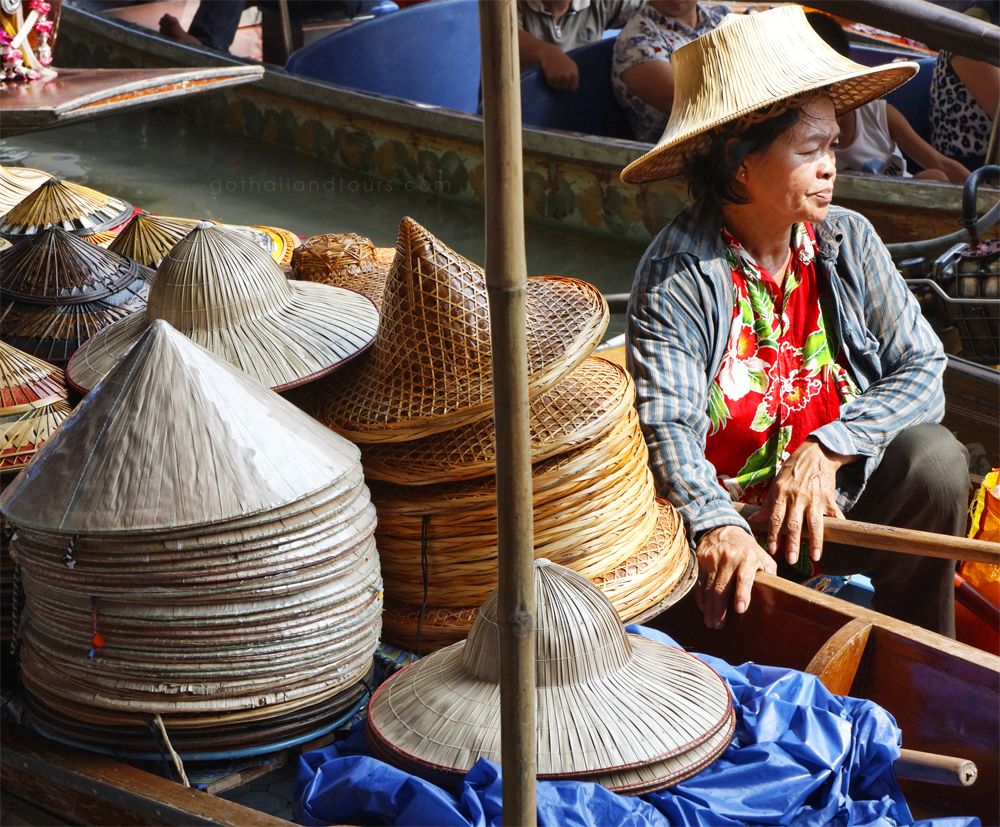
The design and thick material of Sisu's outfit is clearly inspired by hill tribe clothing from the northern part of Southeast Asia bordering with China, most probably the Hmong 



Speaking of Sisu, it was a nice touch how she's addressed as Sisu Datu. The title datu is an Austronesian word for a leader or elder, historically used for chieftains, monarchs, and tutelary spirits of sacred spaces
https://twitter.com/uglyluhan/status/1087968786836320257?s=19
Malay cognates of datu include ratu (queen) and datuk (grandfather). Datuk and the derivate Dato' are still given as titles in Malaysia
therakyatpost.com/2020/01/14/how…
therakyatpost.com/2020/01/14/how…
The music is a bit of a missed opportunity. While its said to feature some SEAsian instruments, I noticed very little of that while watching the movie. One track that stood out is Search for the Last Dragon, but I'll let you search for it yourself
It's a crime that gamelan wasn't featured. Heck, practically the entire soundtrack could be done on gamelan and I'd call it an improvement
https://twitter.com/uglyluhan/status/1173286524646936577?s=19
The single biggest issue I have with this movie is the design of the dragons. I'm not the only one who said so, but the haters often get it wrong too. I did a thread on dragons of South and Southeast Asia here
https://twitter.com/uglyluhan/status/1192017460955762689?s=19
Most Southeast Asian dragons are limbless, but they often have legs in Malaysia and Indonesia. The Vietnamese dragon is based on its Chinese counterpart, and always has legs
https://twitter.com/uglyluhan/status/1192038363227770880?s=19
In Thai, the word mangkhon (from the Sanskrit makara) is commonly used for dragons with legs, and nak (meaning naga) for the limbless type. Technically a makara and a dragon are different creatures but think of it like the difference between a wyrm, wyvern and drake in D&D 

All the dragons featured in Raya have legs, but I can accept that. They also all have a single horn, meant to represent the horn/crest of Southeast Asian dragons 

What's most unforgivable is the face and the addition of fur. Never have I seen even one Southeast Asian depiction of a dragon covered in fur. If someone can show me an exception, please do. These are water creatures. What do they even need the fur, um, for? 

Scott Watanabe explains here that the Ghibli-inspired art was something he was doing early on because it let him generate ideas fast. The resemblance to Haku from Spirited Away is plain to see. It's on the directors for approving it
instagram.com/p/CMnfMl8D_9s/…
instagram.com/p/CMnfMl8D_9s/…
In this concept art, Sisu looks more like a real Southeast Asian dragon. I'm not sure what changed. Especially the Elsa-meets-MLP face. The final design barely even looks Asian, and not Southeast Asian at all 

Despite my gripes with Sisu's design, many of the critics in Southeast Asia seem equally unfamiliar with local dragon legends. An example is the complaint that Sisu in dragon form looks "too Chinese"
Southeast Asian dragons often do resemble the Chinese dragon. In Vietnam especially but very often in Malaysia, Indonesia, sometimes in Thailand. If Sisu looked exactly like a Chinese dragon, I wouldn't even complain


https://twitter.com/uglyluhan/status/1192039845490618368?s=19


I was surprised to find some Indonesians on social media who thought the dragon of Indonesia is a Komodo dragon. Bruh.. the Komodo dragon is a monitor lizard that was dubbed a "dragon" by the naturalist William Douglas Burden 

The Komodo monitor is not the dragon of Indonesian mythology. There are plenty of representations of dragons in traditional Indonesian art
https://twitter.com/uglyluhan/status/1192038022209884160?s=19
"Our dragons don't fly"
Some Southeast Asian dragons can't fly. For example, the golden dragon in Hikayat Raja Budiman appears not be able to leave the water. But if anything, this is an exception
Some Southeast Asian dragons can't fly. For example, the golden dragon in Hikayat Raja Budiman appears not be able to leave the water. But if anything, this is an exception
https://twitter.com/uglyluhan/status/1391697363266195456?s=19
Flight is a common ability among dragons in SEA just as in other parts of Asia. Malays believed dragons would fly to and from the tops of mountains, for example. Some even had wings for that purpose, but wingless dragons could fly too 

For some improved Sisu redesigns by Southeast Asians, take a look here
https://twitter.com/bloodwurm/status/1354954434871083012?s=19
Now before I end this thread, I have to address some of the criticism regarding how well the movie represents Southeast Asia. Some I agree with, others I don't. I was fine with the cast, but I understand that many would prefer if actual Southeast Asians were chosen
Raya has drawn a lot of comparisons with the Airbender franchise simply because it's Asian-based. Avatar was not the first or the best Asian-inspired setting, but it is notable for being the best western-created setting inspired by Asian cultures for its time
Airbender is not the definitive Asian fantasy, but I think the comparison is fair. Like Korra, Raya centres around a group of colour-coded nations which have an uneasy peace before some disaster happens, after which the hero journeys to every land 



But in this article, the writer praises Avatar as the superior setting, partly because each of the four nations are identifiable with "Inuit, Chinese, Tibetan, and Japanese cultures"
vox.com/22306443/raya-…
vox.com/22306443/raya-…
Excuse me, that isn't the case. The Fire Nation bears little specific resemblance to Japan aside from some western stereotypes of honour and militarisation. As a Southeast Asian, I saw more similarities to my own culture than Japan 





Almost all the fighting styles in Avatar are based exclusively on Chinese martial arts. The animals are based on non-Asian species. The Inuit aren't even Asian. The names are all over the place. What is "Toph"? Don't get me wrong, I'm not tryna bash Avatar here
But despite anyone's nostalgia, it's not a perfect representation of Asia, and its world-building isn't always consistent. Say you prefer that series for its better character development or something instead
But one of the absolute worst complaints about the setting of Raya is that the film should've used a single country/culture as a basis instead of viewing Southeast Asia "as a monolith"🙄
This is not a case of the west messing up. This is Southeast Asians looking at our very interconnected region from a modern nationalistic perspective that should have no place in fantasy
I'd have no problem with a setting based on a single part of Southeast Asia. In fact, I did a thread on possible classes for a hypothetical Malay/Nusantara based role-playing game
https://twitter.com/uglyluhan/status/1378436928144470017?s=19
But there's nothing wrong with a setting based on a borderless Southeast Asia as a whole. It was done with Wakanda, the Middle Eastern setting of Aladdin, the Oceanic setting of Moana, and every popular European-based fantasy 







"Our cultures are too different" you say? Not so. We're just fed a very specific version of culture that needs to emphasise each country's supposed uniqueness for tourism
https://twitter.com/uglyluhan/status/1356958905071407105?s=19
You can see what I'm talking about in this (otherwise decent) article which says that floating markets are associated with Thailand, but sarongs are a Malay/Indonesian tradition
sinema.sg/2021/03/23/ray…
sinema.sg/2021/03/23/ray…
Thailand is famous for its floating markets, but they're not unique. They exist around Southeast Asia, including Indonesia
tourism-review.com/fascinating-fl…
tourism-review.com/fascinating-fl…
And more importantly, by what stretch of the imagination are sarongs specific to Malaysia and Indonesia? I can only assume the writer has never been to the Southeast Asian mainland 



Calling Kumandra a "hodgepodge" or "buffet" is a very, very modern, post-colonial, and historically blind way of looking at it. In cases like this we should think regionally and not nationally. Do watch this video to understand what I mean
Another example of this is trying to separate insular Southeast Asia from the mainland, a sentiment particularly common among Malaysians. In other words, they want a fantasy setting that doesn't blend Indo-Malay influences with the rest of the region 

This has more to do with politics and poor teaching of history in schools. Historical Indo-Malay culture really isn't as unique as we like to think, either in culture or folklore
https://twitter.com/uglyluhan/status/1356956719079772161?s=19
In fact, almost every part of Southeast Asia was connected by trade, similar customs, mythologies, and beliefs, even without the Hindu-Buddhist influence. Yes this includes the Philippines, despite what the "islander" fetishists believe
https://twitter.com/uglyluhan/status/1284187938369073152?s=19
Related to this is the inherent essentialism of terms and phrases like "brownface" or "embrace the brown". Skin colour as a representation of cultural identity was never a Southeast Asian thing, but became popular in recent years to distinguish "natives" from Chinese & Indians
And as much as i support calls to embrace the diversity of skin tones we have in Asia, stereotyping ourselves as "brown" is just reviving colonial pseudoscience. Plenty of Southeast Asians are fair even without being mixed
https://twitter.com/uglyluhan/status/1195980419126030337?s=19
This is something that the movie got right. The characters don't all have the same skin tone. Even the shades of brown vary, as in real life. If anything, I would've made the people of Spine lighter skinned
https://twitter.com/HindiAkoSiElina/status/1318952700483174402?s=19
Realistically, it's naive to expect Hollywood to perfectly represent Asia. In fact, I barely even expect it from Southeast Asian creatives. Raya isn't SEAsian fantasy. It's generic fantasy with an Asian aesthetic. You could easily swap the Southeast Asian theme for something else
There's almost nothing in the plot Raya that directly references Southeast Asian mythology. And yet.. I was satisfied. I don't need to see 19th century baju Melayu to feel represented. Is the setting what I would've done? No. But it's not bad either
I've wished for a South or Southeast Asian Disney story since I was a teenager. Seeing a Southeast Asian character alongside the other Disney princesses means more to me than some SEAsian becoming popular in the west 

• • •
Missing some Tweet in this thread? You can try to
force a refresh







